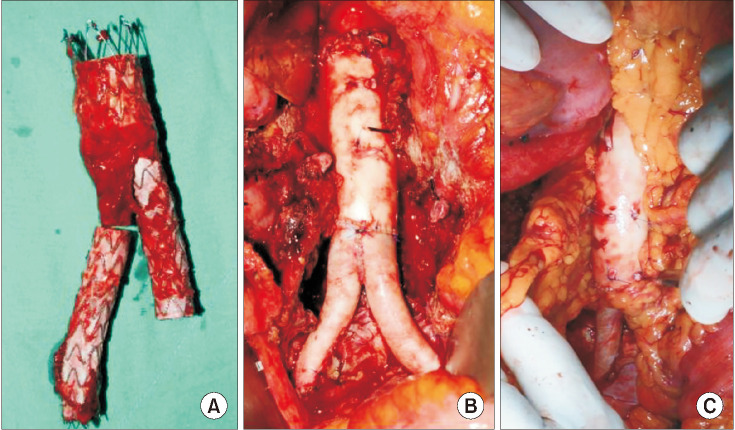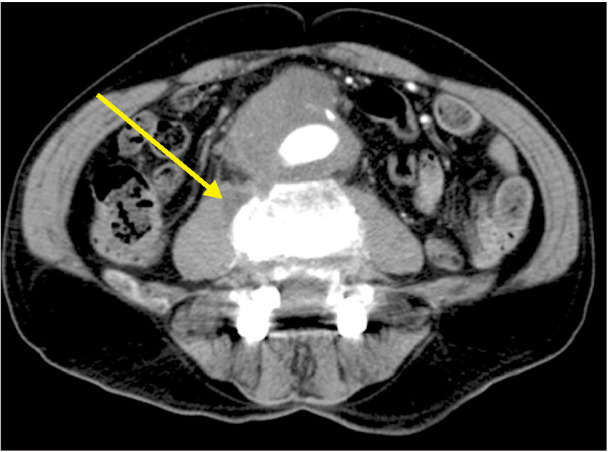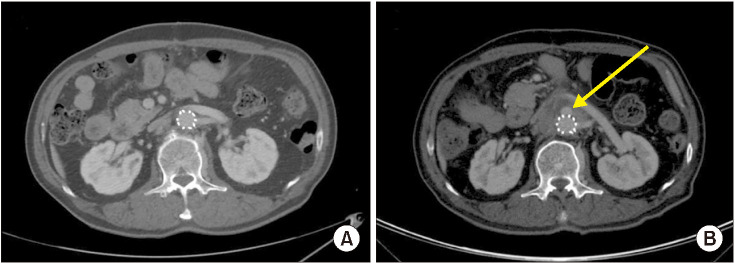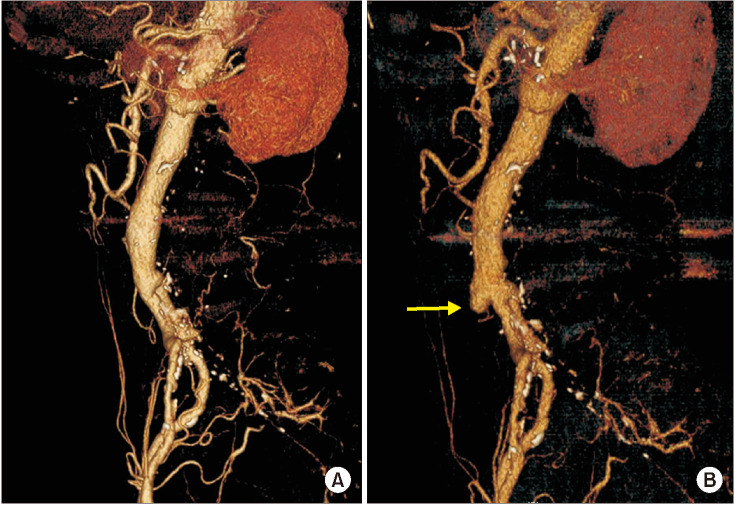Ann Surg Treat Res.
2020 Dec;99(6):344-351. 10.4174/astr.2020.99.6.344.
Strategy to avoid open surgical conversion after endovascular aortic aneurysm repair for patients with infrarenal abdominal aortic aneurysm
- Affiliations
-
- 1Department of Surgery, Jeonbuk National University Hospital, Jeonju, Korea
- 2Division of Vascular Surgery, Department of Surgery, Samsung Medical Center, Sungkyunkwan University School of Medicine, Seoul, Korea
- 3Department of Internal Medicine, Samsung Medical Center, Sungkyunkwan University School of Medicine, Seoul, Korea
- 4Cardiac and Vascular Center, Samsung Medical Center, Seoul, Korea
- 5Division of Vascular Surgery, Department of Surgery, Kangbuk Samsung Hospital, Seoul, Korea
- KMID: 2508934
- DOI: http://doi.org/10.4174/astr.2020.99.6.344
Abstract
- Purpose
Open surgical conversion (OSC) is the last treatment option for patients with endovascular aneurysm repair (EVAR) failure. We investigated the underlying causes of EVAR failure requiring OSC and attempted to determine strategies to avoid OSC after EVAR.
Methods
We retrospectively reviewed the database of patients who underwent OSC after EVAR from 2005 to 2018 in a single institution. Twenty-six OSCs were performed in 24 patients (median age, 74.5 years; 79.2% of males) who had undergone standard EVAR. We investigated pre-, intra-, and postoperative computed tomography or angiographic images and outcomes of the OSCs.
Results
Two main indications for OSC were persistent endoleak (50.0%) and endograft infection (EI) (38.5%). All 13 patients who underwent OSC due to endoleaks received EVAR outside of indications for use. Among 10 patients who underwent OSC due to EI, we found overlooked infection sources in 7 (70.0%) at the time of EVAR or during the surveillance period. OSC was performed at a median of 31.8 months (interquartile range, 9.4–69.8) after EVAR as an emergency (15.4%) or elective (84.6%) surgery. Aortic endograft was removed in 84.6% of cases (totally, 57.7%; partially, 26.9%), whereas it was preserved in 4 cases (15.4%). After 26 OSCs, 2 early deaths (7.7%) and 2 aortoenteric fistulae (7.7%) developed as major complications.
Conclusion
OSC after EVAR was associated with relatively higher perioperative morbidity and mortality. To avoid OSC after EVAR, we recommend careful assessment of coexisting infection sources and avoidance of EVAR for patients with especially unfavorable anatomy for EVAR, particularly the in proximal neck.
Figure
Reference
-
1. Chaikof EL, Dalman RL, Eskandari MK, Jackson BM, Lee WA, Mansour MA, et al. The Society for Vascular Surgery practice guidelines on the care of patients with an abdominal aortic aneurysm. J Vasc Surg. 2018; 67:2–77. PMID: 29268916.2. EVAR Trial Participants. Endovascular aneurysm repair versus open repair in patients with abdominal aortic aneurysm (EVAR trial 1): randomised controlled trial. J Vasc Surg. 2005; 42:592.3. Patel R, Sweeting MJ, Powell JT, Greenhalgh RM. EVAR trial investigators. Endovascular versus open repair of abdominal aortic aneurysm in 15-years' follow-up of the UK endovascular aneurysm repair trial 1 (EVAR trial 1): a randomised controlled trial. Lancet. 2016; 388:2366–2374. PMID: 27743617.4. Greenhalgh RM, Brown LC, Kwong GP, Powell JT, Thompson SG. EVAR trial participants. Comparison of endovascular aneurysm repair with open repair in patients with abdominal aortic aneurysm (EVAR trial 1), 30-day operative mortality results: randomised controlled trial. Lancet. 2004; 364:843–848. PMID: 15351191.5. Millon A, Deelchand A, Feugier P, Chevalier JM, Favre JP. University Association for Research in Vascular Surgery (AURC). Conversion to open repair after endovascular aneurysm repair: causes and results. A French multicentric study. Eur J Vasc Endovasc Surg. 2009; 38:429–434. PMID: 19589700.6. Moulakakis KG, Dalainas I, Mylonas S, Giannakopoulos TG, Avgerinos ED, Liapis CD. Conversion to open repair after endografting for abdominal aortic aneurysm: a review of causes, incidence, results, and surgical techniques of reconstruction. J Endovasc Ther. 2010; 17:694–702. PMID: 21142475.7. Harris PL, Vallabhaneni SR, Desgranges P, Becquemin JP, van Marrewijk C, Laheij RJ. Incidence and risk factors of late rupture, conversion, and death after endovascular repair of infrarenal aortic aneurysms: the EUROSTAR experience. European Collaborators on Stent/graft techniques for aortic aneurysm repair. J Vasc Surg. 2000; 32:739–749. PMID: 11013038.8. Ultee KH, Soden PA, Zettervall SL, Darling J, Verhagen HJ, Schermerhorn ML. Conversion from endovascular to open abdominal aortic aneurysm repair. J Vasc Surg. 2016; 64:76–82. PMID: 27345505.9. Terramani TT, Chaikof EL, Rayan SS, Lin PH, Najibi S, Bush RL, et al. Secondary conversion due to failed endovascular abdominal aortic aneurysm repair. J Vasc Surg. 2003; 38:473–477. PMID: 12947259.10. Lyons OT, Baguneid M, Barwick TD, Bell RE, Foster N, Homer-Vanniasinkam S, et al. Diagnosis of aortic graft infection: a case definition by the management of aortic graft infection collaboration (MAGIC). Eur J Vasc Endovasc Surg. 2016; 52:758–763. PMID: 27771318.11. Heo SH, Kim YW, Woo SY, Park YJ, Kim DK, Chung DR. Recent results of in situ abdominal aortic reconstruction with cryopreserved arterial allograft. Eur J Vasc Endovasc Surg. 2017; 53:158–167. PMID: 27592735.12. Kouvelos G, Koutsoumpelis A, Lazaris A, Matsagkas M. Late open conversion after endovascular abdominal aortic aneurysm repair. J Vasc Surg. 2015; 61:1350–1356. PMID: 25817560.13. Georgiadis GS, Trellopoulos G, Antoniou GA, Gallis K, Nikolopoulos ES, Kapoulas KC, et al. Early results of the Endurant endograft system in patients with friendly and hostile infrarenal abdominal aortic aneurysm anatomy. J Vasc Surg. 2011; 54:616–627. PMID: 21802890.14. Turney EJ, Steenberge SP, Lyden SP, Eagleton MJ, Srivastava SD, Sarac TP, et al. Late graft explants in endovascular aneurysm repair. J Vasc Surg. 2014; 59:886–893. PMID: 24377945.15. Jimenez JC, Moore WS, Quinones-Baldrich WJ. Acute and chronic open conversion after endovascular aortic aneurysm repair: a 14-year review. J Vasc Surg. 2007; 46:642–647. PMID: 17764870.16. van Marrewijk CJ, Fransen G, Laheij RJ, Harris PL, Buth J. EUROSTAR Collaborators. Is a type II endoleak after EVAR a harbinger of risk? Causes and outcome of open conversion and aneurysm rupture during follow-up. Eur J Vasc Endovasc Surg. 2004; 27:128–137. PMID: 14718893.17. Lifeline Registry of EVAR Publications Committee. Lifeline registry of endovascular aneurysm repair: long-term primary outcome measures. J Vasc Surg. 2005; 42:1–10. PMID: 16012445.18. Klonaris C, Lioudaki S, Katsargyris A, Psathas E, Kouvelos G, Doulaptsis M, et al. Late open conversion after failed endovascular aortic aneurysm repair. J Vasc Surg. 2014; 59:291–297. PMID: 24139568.19. Kelso RL, Lyden SP, Butler B, Greenberg RK, Eagleton MJ, Clair DG. Late conversion of aortic stent grafts. J Vasc Surg. 2009; 49:589–595. PMID: 19135829.20. Wu Z, Xu L, Qu L, Raithel D. Seventeen years' experience of late open surgical conversion after failed endovascular abdominal aortic aneurysm repair with 13 variant devices. Cardiovasc Intervent Radiol. 2015; 38:53–59. PMID: 24870699.21. Gallitto E, Gargiulo M, Freyrie A, Bianchini Massoni C, Pini R, Mascoli C, et al. Results of standard suprarenal fixation endografts for abdominal aortic aneurysms with neck length ≤10 mm in high-risk patients unfit for open repair and fenestrated endograft. J Vasc Surg. 2016; 64:563–570. PMID: 27183854.22. Malas MB, Hicks CW, Jordan WD Jr, Hodgson KJ, Mills JL Sr, Makaroun MS, et al. Five-year outcomes of the PYTHAGORAS U.S. clinical trial of the Aorfix endograft for endovascular aneurysm repair in patients with highly angulated aortic necks. J Vasc Surg. 2017; 65:1598–1607. PMID: 28190716.23. Jordan WD Jr, Mehta M, Varnagy D, Moore WM Jr, Arko FR, Joye J, et al. Results of the ANCHOR prospective, multicenter registry of EndoAnchors for type Ia endoleaks and endograft migration in patients with challenging anatomy. J Vasc Surg. 2014; 60:885–892. PMID: 25088739.24. Usatii A, Payne W, Santilli S. Removal of an infected aortic endograft and open aortic reconstruction: technical remarks. Ann Vasc Surg. 2013; 27:679–683. PMID: 23535520.25. Matsagkas M, Kouvelos GN, Peroulis M. Safe and fast proximal aortic control using an aortic balloon through direct graft puncture for the explantation of an abdominal endograft with suprarenal fixation. Interact Cardiovasc Thorac Surg. 2014; 18:519–521. PMID: 24449762.26. Schermerhorn ML, O'Malley AJ, Jhaveri A, Cotterill P, Pomposelli F, Landon BE. Endovascular vs. open repair of abdominal aortic aneurysms in the Medicare population. N Engl J Med. 2008; 358:464–474. PMID: 18234751.27. Murphy EH, Szeto WY, Herdrich BJ, Jackson BM, Wang GJ, Bavaria JE, et al. The management of endograft infections following endovascular thoracic and abdominal aneurysm repair. J Vasc Surg. 2013; 58:1179–1185. PMID: 23830947.28. Fatima J, Duncan AA, de Grandis E, Oderich GS, Kalra M, Gloviczki P, et al. Treatment strategies and outcomes in patients with infected aortic endografts. J Vasc Surg. 2013; 58:371–379. PMID: 23756338.29. Nishimura RA, Otto CM, Bonow RO, Carabello BA, Erwin JP 3rd, Fleisher LA, et al. 2017 AHA/ACC focused update of the 2014 AHA/ACC Guideline for the Management of Patients With Valvular Heart Disease: a report of the American College of Cardiology/American Heart Association Task Force on Clinical Practice Guidelines. Circulation. 2017; 135:e1159–e1195. PMID: 28298458.
- Full Text Links
- Actions
-
Cited
- CITED
-
- Close
- Share
- Similar articles
-
- Novel Technique to Rescue a Folded Aortic Endograft during Endovascular Aneurysm Repair
- Ruptured Abdominal Aortic Aneurysm with Antecedent Endovascular Repair of Abdominal Aortic Aneurysm
- Abdominal Aortic Aneurysm
- Endovascular Stent-Graft Placement and Secondary Intervention for Abdominal Aortic Aneurysm in a Patient who had a Previously Inserted Iliac Stent
- General Considerations of Ruptured Abdominal Aortic Aneurysm: Ruptured Abdominal Aortic Aneurysm





